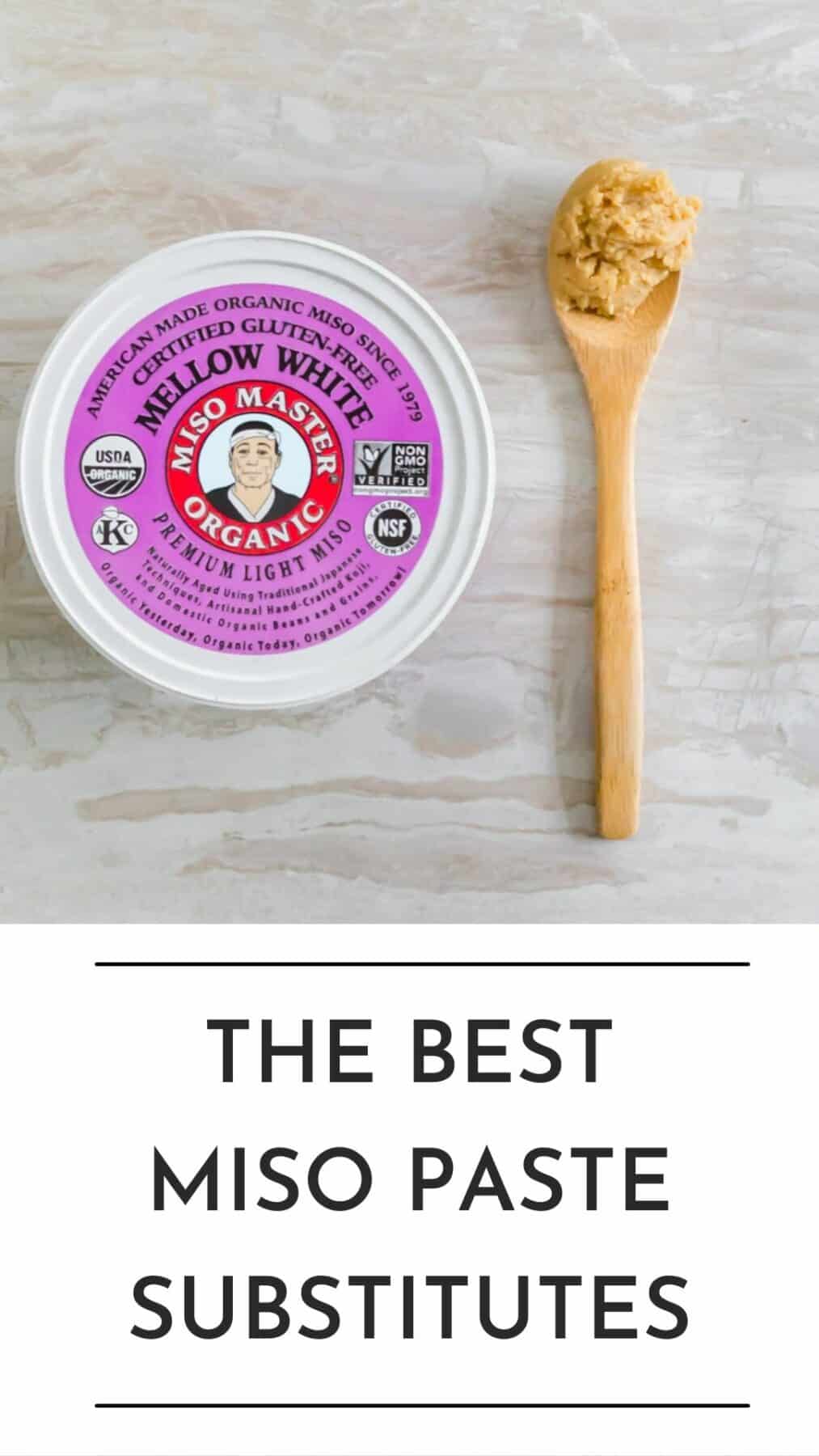When it comes to adding that umami-packed punch to your dishes, few ingredients can rival the irresistible flavor of white miso paste.
However, what do you do when you’re all out of this delectable ingredient?
Fear not, for we’ve got you covered with some intriguing alternatives that will have your taste buds dancing.
From the rich depth of soy sauce to the tangy kick of fish sauce, and even the gluten-free wonders of tamari – let’s dive into the world of white miso substitutes that will leave you craving for more.
Get ready to unlock a world of culinary possibilities!
white miso substitute
A good substitute for white miso paste is soy sauce, which can be used in a ratio of ½ tablespoon soy sauce for 1 tablespoon of miso paste.
If you don’t have soy sauce, you can use gluten-free or soy-free alternatives such as tamari, coconut aminos, or liquid aminos as substitutes for miso paste.
Another option is fish sauce, which can be used in a ratio of ½ teaspoon fish sauce for 1 tablespoon miso paste.
However, it’s important to note that miso paste is a unique ingredient and should be sought out if possible.
Key Points:
- A good substitute for white miso paste is soy sauce.
- Soy sauce can be used in a ratio of ½ tablespoon for 1 tablespoon of miso paste.
- Gluten-free or soy-free alternatives such as tamari, coconut aminos, or liquid aminos can also be used as substitutes for miso paste.
- Fish sauce can be used as an alternative, in a ratio of ½ teaspoon for 1 tablespoon of miso paste.
- Miso paste is a unique ingredient and should be sought out if possible.
- It’s important to note that the substitutes may not provide the exact same flavor as miso paste.
white miso substitute – Watch Video


Pro Tips:
1. Did you know that peanut butter can be a surprising substitute for white miso? Its creamy texture and slightly nutty flavor can work as a replacement in certain recipes.
2. In Korean cuisine, there is a type of fermented soybean paste called doenjang, which can be used as a white miso substitute. Although it has a stronger and saltier flavor, it adds a unique depth to dishes.
3. White miso is a good source of probiotics due to the fermentation process involved in its production. These healthy bacteria can help improve digestion and boost the immune system.
4. For a gluten-free alternative to white miso, chickpea miso is an excellent option. Made from fermented chickpeas, it offers a similar taste profile and can be used as a substitute in various recipes.
5. Red miso, which has a longer fermentation period and a deeper flavor, can be used as a white miso substitute with some adjustments in the quantity. It adds a richer umami taste to dishes and can be a great way to experiment with different flavors.
Soy Sauce As Substitute For White Miso Paste
When it comes to finding a suitable substitute for white miso paste, soy sauce emerges as one of the best options available. With a ratio of ½ tablespoon of soy sauce for every 1 tablespoon of miso paste, it provides a complementary flavor to dishes that would normally utilize white miso paste. Soy sauce, a staple in many Asian cuisines, is known for its savory and umami-rich taste, making it an ideal replacement for miso paste. Its versatility allows it to be used in a variety of dishes, adding depth and complexity to the overall flavor profile.
While soy sauce is a convenient alternative, it is important to note that it may not be suitable for individuals with specific dietary restrictions. Fortunately, there are gluten-free and soy-free alternatives that can be used as substitutes for miso paste. Tamari, coconut aminos, and liquid aminos are excellent options for those who need to avoid gluten or soy. These alternatives can mimic the flavor and texture of miso paste, ensuring that individuals with dietary restrictions can still enjoy the distinctive taste associated with Japanese cuisine.
Gluten-Free And Soy-Free Alternatives For White Miso Paste
For individuals with specific dietary requirements, finding a suitable substitute for white miso paste can be a challenge. However, there are alternatives available that cater to those who need to avoid gluten or soy. Tamari, a gluten-free soy sauce, can be used in the same ratio as soy sauce – ½ tablespoon of tamari for every 1 tablespoon of miso paste. Its deep and rich flavor can replicate the umami taste that miso paste imparts.
Coconut aminos and liquid aminos are additional substitutes to consider for those with soy allergies. These alternatives provide a similar taste and texture to miso paste, making them viable options for individuals seeking a soy-free alternative. The substitution ratio remains the same, with ½ tablespoon of either coconut aminos or liquid aminos replacing 1 tablespoon of miso paste.
Fish Sauce As An Alternative For White Miso Paste
While soy-based substitutes are commonly used, fish sauce can also be a suitable alternative for white miso paste. Fish sauce offers a distinctive and pungent flavor, which can provide a unique twist to a dish that typically calls for miso paste.
When substituting white miso paste with fish sauce, it is recommended to use ½ teaspoon of fish sauce for every 1 tablespoon of miso paste. This ratio allows for a balanced flavor profile and prevents the dish from becoming overly fishy.
Fish sauce, an integral ingredient in Southeast Asian cuisine, is fermented from small fish such as anchovies. It enhances the umami taste and contributes to the overall complexity of various dishes. While fish sauce may not be an obvious choice for substituting white miso paste, it can be a delightful alternative for those who appreciate its distinctive flavor.
- Fish sauce can be used as a substitute for white miso paste.
- Use ½ teaspoon of fish sauce for every 1 tablespoon of miso paste.
- Fish sauce enhances umami taste and adds complexity to dishes.
Importance Of Seeking Out Miso Paste
Miso paste, made from fermented soybeans, has a distinct and difficult-to-replicate flavor profile. Its rich and savory taste adds depth to dishes and complements a range of ingredients. While soy sauce, tamari, coconut aminos, and fish sauce can substitute for white miso paste, they cannot fully capture its complexity and nuances.
For those who truly appreciate the authentic taste of Japanese cuisine or for recipes that specifically call for miso paste, it is highly recommended to seek out and use the real thing. Miso paste can be found in grocery stores, typically in the international foods aisle, specifically near the Japanese ingredients section. By using miso paste, individuals can ensure they are experiencing the true essence and flavor that it brings to their dishes.
Understanding The Intense Flavor Of Miso Paste
Miso paste is renowned for its intense savory flavor, known as umami, which is a taste sensation that tantalizes the taste buds. It is this unique quality that distinguishes miso paste from other condiments or flavorings. The fermentation process gives rise to complex compounds that result in a rich, deep, and satisfying taste.
The flavors in miso paste develop over time as the soybeans ferment. Different miso varieties offer varying levels of flavor intensity. White miso paste, with its lighter color and milder taste, appeals to a wide range of palates. However, it is crucial to note that the intensity of miso paste can vary depending on the brand and the length of its fermentation.
The distinct umami flavor of miso paste makes it a prized ingredient in Japanese cuisine and adds a delightful layer of taste to a variety of dishes, from:
- soups
- marinades
- dressings
- glazes
The unique combination of savory, earthy, and slightly sweet notes provides a depth of flavor that is difficult to replicate with any other substitute.
Miso paste truly enhances the taste of any dish and elevates the overall dining experience.
Traditional Use Of Miso Paste In Japanese Dishes
Miso paste is a versatile and essential ingredient in traditional Japanese cuisine, adding depth and enhancing flavors. One popular example is miso ramen, a comforting soup that showcases the umami-rich miso broth, chewy noodles, and various toppings, creating a satisfying and soul-nourishing experience.
Miso paste is also used to marinate salmon, resulting in a succulent and savory dish with a unique umami taste. This combination has become a staple in Japanese cuisine, gaining popularity worldwide.
Furthermore, miso paste can be used as a substitute for adding a cheesy flavor, as seen in vegan pesto. It provides a similar umami taste to Parmesan cheese, adding depth to the overall dish. Its versatility allows for creative culinary applications, extending beyond traditional Japanese recipes.
In summary, miso paste plays a crucial role in various Japanese dishes, elevating flavors and providing a distinctive umami taste. Its applications extend beyond soups and seafood, making it an ingredient worth exploring in different culinary creations.
Miso Paste As A Cheesy Flavor Substitute
For individuals following a plant-based or vegan diet, miso paste can be a valuable substitute for adding a cheesy flavor. While miso paste does not replicate the exact taste of cheese, it offers a distinctive umami taste that can create a similar sensation on the palate. In dishes like vegan pesto, replacing Parmesan cheese with miso paste can contribute a depth of flavor that mimics the cheesy taste.
The salty and savory notes of miso paste can help achieve a savory profile that is reminiscent of cheese, making it an excellent alternative for individuals seeking a vegan or lactose-free option. Additionally, miso paste is a nutritious ingredient that provides essential minerals and beneficial bacteria due to the fermentation process, making it a healthier choice compared to traditional cheese.
Bullet points:
- Miso paste can add a cheesy flavor to plant-based or vegan dishes.
- It offers a distinctive umami taste.
- Replacing Parmesan cheese with miso paste in dishes like vegan pesto can provide a depth of flavor.
- Miso paste’s salty and savory notes can help achieve a savory profile reminiscent of cheese.
- It is a nutritious ingredient that provides essential minerals and beneficial bacteria.
- Miso paste is a healthier choice compared to traditional cheese.
“Miso paste can be a valuable substitute for adding a cheesy flavor.”
Exploring Different Types Of Miso
Miso paste is available in various types, each with its own distinct characteristics and flavors. Common types include:
-
Yellow miso: Also known as “shinsu” miso in Japan, this is the mildest and sweetest type of miso paste. It has a light golden color and is well-suited for delicate dishes or those that require a milder flavor.
-
White miso: Also known as “shiro” miso, this variety has a pale yellow color and a slightly sweet taste. It has a lower soybean content and a shorter fermentation period, resulting in a milder and more delicate flavor compared to darker miso types.
-
Red miso: Also known as “aka” miso, this type undergoes a longer fermentation period and has a more pronounced and intense taste. Its dark red color comes from soybeans and barley or rice koji, which is used in the fermentation process. Red miso is often used in hearty stews, soups, and marinades, as its robust flavor can stand up to stronger ingredients.
-
Dark or brown miso: Also known as “genmai” miso, this is the strongest and most pungent variety. Its deep and rich flavor profile makes it ideal for robust dishes and recipes that call for a bold umami punch.
Each type of miso offers a unique flavor experience, allowing individuals to explore and experiment with different tastes to suit their preferences and the requirements of specific recipes.
Finding Miso Paste In The International Foods Aisle
Miso paste is commonly found in grocery stores, specifically in the international foods aisle near the Japanese ingredients. This section usually offers a wide range of Asian cooking essentials, including different types of soy sauce, rice vinegar, and other key components for Japanese cuisine.
When looking for miso paste, be prepared to choose from a variety of types, textures, and brands. The options can be overwhelming, ranging from white miso to red miso. However, having this selection ensures that individuals can find the perfect miso paste for their preferred taste and recipe. It is highly recommended to carefully read the labels and pay attention to the fermentation period, soybean content, and any additional ingredients. These factors have a significant impact on the final flavor of the miso paste.
- Miso paste is typically found in the international foods aisle of grocery stores.
- Look for miso paste near other Japanese ingredients.
- The Asian cooking essentials section usually contains various types of soy sauce and rice vinegar.
- There are different types, textures, and brands of miso paste available.
- White miso and red miso are popular choices.
- Read the labels carefully to understand the fermentation period, soybean content, and additional ingredients.
- The flavor of miso paste is greatly influenced by these factors.
“When searching for miso paste, be prepared to choose from a variety of types, textures, and brands.”
Bottom Line: Substituting White Miso Paste
While white miso paste is a unique ingredient with its own distinct flavor, there are suitable substitutes available.
- Soy sauce, with a ratio of ½ tablespoon for every 1 tablespoon of miso paste, can mimic the umami taste.
- Gluten-free and soy-free alternatives like tamari, coconut aminos, and liquid aminos can also be used as substitutes.
- Fish sauce, when used in a ratio of ½ teaspoon for every 1 tablespoon of miso paste, offers an alternative with its distinct flavor.
However, it is important to recognize that miso paste cannot be fully replaced by substitutes. The intense flavor and depth it brings to dishes are unparalleled. For those who truly want to experience the authentic taste of Japanese cuisine or when a recipe specifically calls for miso paste, it is recommended to seek out the real thing. Miso paste can be found in the international foods aisle, providing an opportunity to explore its different types and flavors.
Whether using a substitute or the genuine miso paste, both options unlock a world of delicious possibilities. The decision ultimately lies in the hands of the cook and their preferences, dietary needs, and culinary aspirations.
- Soy sauce (½ tbsp per 1 tbsp of miso paste)
- Tamari (gluten-free and soy-free alternative)
- Coconut aminos (gluten-free and soy-free alternative)
- Liquid aminos (gluten-free and soy-free alternative)
- Fish sauce (½ tsp per 1 tbsp of miso paste)

You may need to know these questions about white miso substitute
What is a good substitute for white miso?
It has a similar deep umami taste that adds depth to dishes. While it may not have the same fermented complexity as miso, soy sauce can still enhance the flavors of soups, stews, and marinades, making it a suitable alternative.
What does white miso do in a recipe?
White miso serves as a key ingredient in various recipes by contributing a unique flavor profile. Its addition to stir-fry sauces enhances the taste, creating a savory and tangy element that beautifully complements other components. Alongside ingredients like garlic, soy sauce, rice vinegar, brown sugar, and toasted sesame oil, white miso adds depth and complexity to the overall dish. Additionally, it can be utilized to create miso butter, which can be stirred into the stir-fry towards the end of cooking, infusing the dish with a rich and flavorful glaze.
What is in white miso?
White miso is a savory paste that is made from a combination of soybeans, rice, salt, and water. It undergoes fermentation with Aspergillusoryzae, the same culture used in the production of sake and soy sauce. This fermentation process not only gives white miso its unique flavor but also enhances its nutritional value. With its high-quality protein content, white miso is an excellent option for individuals who prefer plant-based alternatives or have limited meat consumption in their diet.
What can I use instead of white miso in salad dressing?
When seeking an alternative to white miso in salad dressing, you can consider using tamari sauce. Tamari, a type of soy sauce, can provide a similar flavor profile and is a suitable substitute for miso. Alternatively, you could experiment with incorporating a small amount of tahini or anchovy paste to thicken and enhance the taste of soy sauce in your dressing, ensuring a satisfying and flavorful salad experience.
Reference source
https://www.runningtothekitchen.com/miso-paste-substitute/
https://www.acouplecooks.com/miso-substitute/
https://www.cooksmarts.com/articles/best-ways-to-use-miso/
https://www.gourmetfoodworld.com/hikari-miso-white-miso-paste-11930



